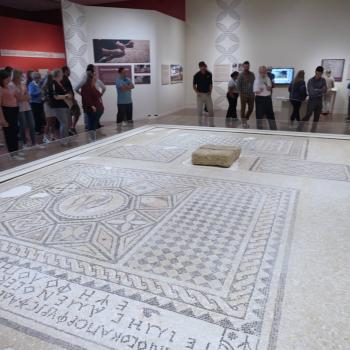Their holy places are woods and groves, and they apply the names of Deities to that hidden presence which is seen only by the eye of reverence. [4]
What does all this have to do with prayer? Well, clearly our ancestors understood the power of the Gods to evoke terror. The ancients knew what we in our sanitized world have chosen to forget: no Deity is safe and religious rites are not pabulum for the masses.
To the modern mind, this may be difficult to fully comprehend. Those of us raised in the late 20th century are used to manicured, complacent, and most of all safe Deities. Even modern fainings [5] are not generally structured around the sense that the Gods are active, immense, and potentially dangerous. We have lost the awareness that our ancestors so clearly had: that hand in hand with the ecstasy or awe Divine manifestation can bring, also often comes terror. Prayer then, provides a means for the Gods to interact with us in a more structured manner, and also a means whereby we may be taught to interact with Them. It allows us to channel the force of that contact with the "mysterium tremendens" in a way that is healthy and useful, and that allows us to deepen our personal connection with the Gods.
Otto writes at length about the ability of the Divine to evoke both terror (tremendens) and ecstasy (what he calls fascination or fascinans). Anyone who doubts the veracity of this within our Northern family of Gods need only look to Woden: God of terror, ecstasy, and inspiration (among many other things). To His men, He brings heart-stopping terror and to His women, ecstasy and seduction. So might any God. When we remove our Gods from the pages of the Eddas and Sagas, when we allow Them the life that They so clearly have, we must of necessity, open ourselves up to the fullness of religious experience, experience that may not be clearly defined in the pages of lore. The winding pathway that will guide us through that is the discipline of prayer.
Christian author Thomas Keating, in writing on centering prayer, notes that "the discipline of Centering Prayer and the other traditional practices are ways of refining our receptive apparatus so that we can perceive the word of God communicating itself with ever greater simplicity to our spirit and to our inmost being." [6] Prayer becomes a "gesture of consent," [7] welcoming the freedom of the Gods to be as They will be, without regard to our comfort or preconceptions. Of course, Keating was writing about his monotheistic God, but the same paradigm holds true within polytheism.
Prayer is the inner reflection of outward worship. It is the foundation of the spiritual impetus that leads to fainings and blót. [8] Our rites are based around the concept of spiritual reciprocity: a gift for a gift. Just as we give libations, sacrifices, and votive gifts, so by prayer are we able to give intent, time, and the gift of an open and willing heart. Our religion does not stress spiritual receptivity; in fact, in many circles it is dismissed as ‘ergi,' [9] but without some level of receptivity to the Gods, religions neither grow nor thrive. In his examination of ancient Greek religion, scholar Walter Burkert writes that "there is rarely a ritual without prayer," and notes that to the ancient mind, "prayer is more an act of drawing attention to oneself than of submission." [10] I would posit that, given the common Indo-European roots of both cultures, the Teutonic tribes may have held a similar view: there is no shame in praying to the Gods and doing so is a necessary part of religious life.
A more modern interpretation of prayer is that of conversations with the Gods. Certainly that is one aspect of prayer. Not everyone can begin at that place though. Many times, our approach to the Gods is formed by the religions in which we were raised. For those coming from religions that habitually portray "God" as something other than our Elder Kin, simple speaking from the heart can be difficult, intimidating, or even embarrassing. This is where structured, formulaic prayer can provide a useful bridge to more freeform methods of personal worship. There are prayer beads, mantras, set prayers like Sigdrifa's Prayer, meditation on passages from the Eddas, altar work, and dozens of other variations. It's important that each person discover the style that works best for him or her; after all, spirituality is both a unique and a uniquely personal journey. Not everyone is going to respond to the same methods. Regardless of method, consistency is essential. The greatest of mystics teach us that the key to a successful prayer life is giving it the time it deserves, daily recognition and honor of the Gods that we purport to love, or at the very least, venerate.
Sigdrifa's Prayer is a wonderful prayer to say upon awakening and makes a lovely spiritual touchstone throughout the day. This prayer is the joyful exclamation of the Valkyrie Sigdrifa upon being awakened from an enchanted sleep. No matter how many times you choose to offer this prayer, there is always something to call to mind the power and blessings of the Gods, even something as simple as the earth beneath our feet. In many ways, it is a universal prayer, one that is equally powerful for both the novice and the experienced Heathen. It contains an immense and complex theology in two simple paragraphs. If nothing else, it's a good place to begin.





